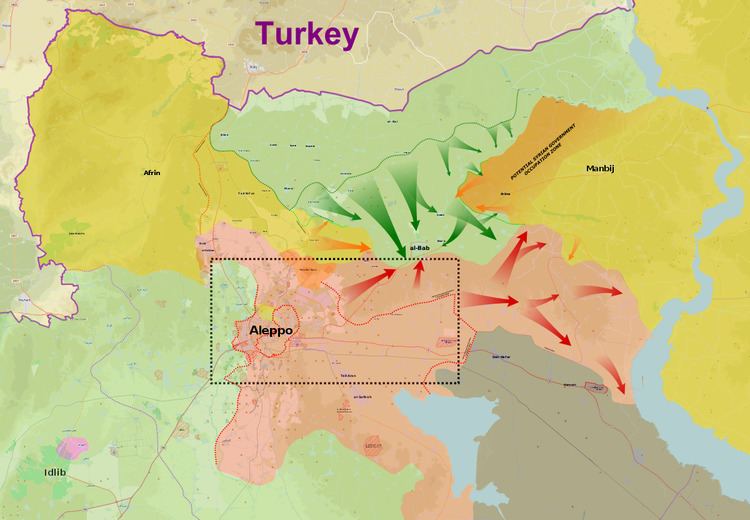 | ||
The safe zone (Turkish: Güvenli Bölge) is an area that has been planned by Turkish authorities to create a buffer zone within Syria. The potential zone is planned between Afrin and Ayn al-Arab districts.
Contents
Background
Turkey and Syrian opposition proposed a safe zone that includes some regions of northern Syria in 2013, however United States and the other Western governments was not willing to accept these plans. After the advancements of ISIL in Iraq, Turkey and United States negotiated 'safe zone', while USA accepted 'ISIL-free zone', US officials were reluctant to accept a no fly zone.
After the attacks of ISIL in Syrian Kurdistan, tens of thousands non-Sunnis, Christians and Yazidis fled to Turkey. In the beginning of 2015, refugees has begun to cross Turkish-Greek border and escaped to European countries. These huge refugee flows caused taking a re-consideration to create a safe zone for civilians in Syria. In February 2016, Chancellor of Germany Angela Merkel said, "In the current situation it would be helpful if there could be such an area where none of the parties are allowed to launch aerial attacks – that is to say, a kind of no-fly zone".
Negotiations
The safe zone in Syria has not been created because of disagreements between US and Turkish governments yet, mainly on the initial actor to be eliminated in Syria. Turkey wants the Bashar Al-Assad regime to be gone as soon as possible while US says the war against ISIS in the main objective of US policies in Syria.
The content of the safe zone is another reason of the disagreement between US and Turkish governments. According to Turkey, the safe zone must include no fly zone, but the US rejects any possibility to establish a no-fly zone. Turkey supports the involvement of Syrian opposition forces in the region after ISIS eliminated. However, the US is reluctant against Syrian opposition for they include many radical Islamist elements.
Turkish Undersecretary Feridun Sinirlioglu expressed the Turkish opinion about the safe zone in August 2015, saying that Turkish forces will strike not only the ISIS force but also the Syrian regime and the Kurdish YPG forces if they enter into the region. Couple of days later, US officials made a statement that they were not to accept any aggressiveness against YPG. According to Turkey, YPG is considered as a threat because of its strong ties with PKK. On the other hand, US says PKK is a terrorist organisation but YPG is a different actor and one of the main allies of US in the war against ISIS. For US, the exclusion of YPG from safe zone areas may cause to a big gap for the fight against radical factors.
The other debate is about the name of the safe zone. Turkey calls the zone as 'safe zone from ISIS, Syrian regime and YPG'. However, US declared they will only accept 'ISIS-free zone'. US has not make any declaration about the possible involvement of Syrian regime to the region.
The Forces of Martyr Ahmad al-Abdo, part of the Free Syrian Army's Southern Front, stated in an interview that if safe zones are used to "divide Syria so terrorist organizations would emerge", the rebel group would "certainly reject them" and will "fight against them". However, the group's commander also stated that if safe zones are used to support internally displaced persons in Syria, then he "will support them".
Zone
Places between Azaz and al-Rai, Syria like Kafr Kalbin, Kafrah, Sawran, Ihtaymilat, Dabiq, Barih, Kafr Elward, Ghoz, Ghaytun, Akhtarin, Baruza, Tall Tanah, Kaljibrin, Qebbet al-Turkmen, Al-Ghandurah, Arab Hassan Sabghir, Mahsenli, and Halwanji have been included to the safe zone. In addition, Erdogan said, "They will leave Manbij. They will to go east of the Euphrates River. If not, we will do what is needed".
International reactions to Trump's safe zone proposals
During and after his campaign, Trump proposed establishing safe zones in Syria as an alternative to Syrian refugees' immigration to the US. In the past "safe zones" have been interpreted as establishing, among other things, no-fly zones over Syria. During the Obama administration Turkey encouraged the US to establish safe zones; the Obama administration was concerned about the potential for pulling the US into a war with Russia. Although safe zones were not in the final version of Trump's controversial Executive Order 13769, an earlier draft leaked several days before would have required the US to create a plan for safe zones in Syria.
On January 30, the Saudi government informed Trump that it supported the creation of safe zones in Syria and Yemen. Two days later, on February 2, Trump discussed safe zones with the government of Jordan. On February 3 the U.S. secured Lebanon's backing for safe zones in Syria. On February 1 Russia asked the U.S. to be more specific on its safe-zone plan and expressed hope the U.S. would discuss it with Russia before implementation. On February 3 the United Nations High Commissioner on Refugees opposed safe zones. On February 10, Syrian President Bashar Assad, while welcoming a notion that U.S. troops might fight alongside Syria, rejected the proposal for safe zones as "not a realistic idea at all". Turkey unveiled a new proposal for safe zones to Sunni Arab states meeting February 13 in Bahrain.
